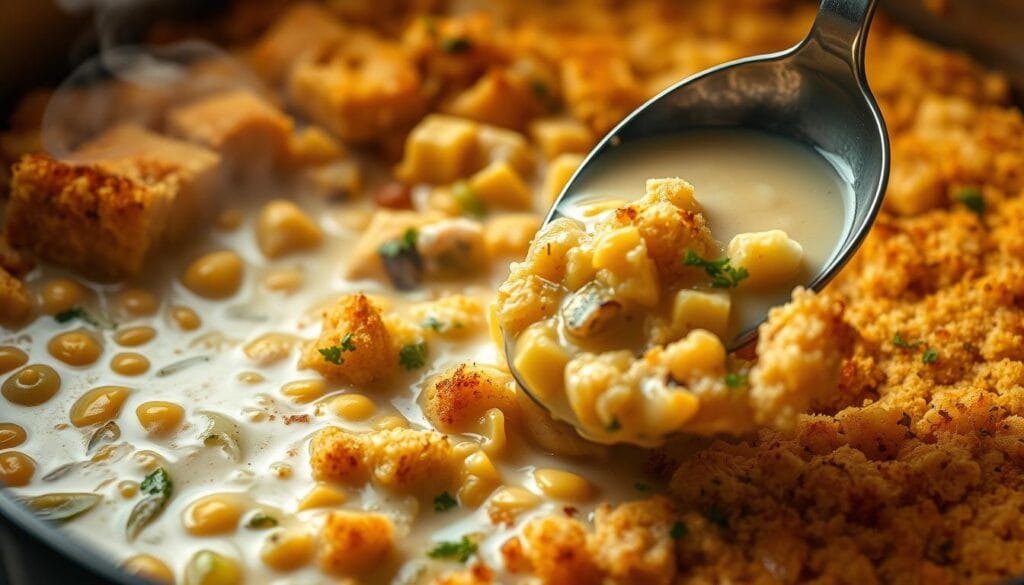What’s the Difference Between Chicken and Dressing vs. Stuffing?
Imagine you’re at a family dinner, and someone asks for the stuffing. But another person says it’s dressing. This isn’t just about words. It shows how different parts of America see food.
In New England, it’s always stuffing, says Butterball’s 2015 survey. But in the South, cornbread dressing is a big hit at 40% of holiday meals. Why do people in different places call it different things?
It’s not just about what to call it. How you cook it matters too. Stuffing is cooked inside a bird, while dressing is made in a dish. But 70% of people still mix up the terms.
Chefs often call it dressing because it absorbs more flavor. The Pilgrims’ meals were different, using herbs instead of bread. This dish has a long history, starting in the 1850s.
Most recipes use bread, like cornbread or baguette. This side dish is more than just a side. It’s a way to show who you are. Let’s explore the myths and why 75% of hosts say it’s essential. Your next debate begins here.
Table of Contents
The Origins of Chicken and Dressing in American Cuisine
Deep in Southern culinary history, cornbread dressing with chicken is a symbol of cultural fusion. Early settlers mixed Native American corn techniques with European seasonings. This created a dish that was both practical and abundant.
Southern Roots of Dressing
Before the 1850s, this dish was called stuffing. The South changed it to “dressing” due to Victorian sensibilities. Cornbread became key in Southern versions, unlike Northern white bread stuffings.
This change showed regional identity and used local resources.
How Chicken Became a Key Ingredient
In the 19th century, chicken became a main part of the recipe. It turned the dish from a side to a protein-packed main course. Families used leftover roasted chicken to make meals more special.
Today, bone-in chicken parts like thighs or breasts are still favorites.
Historical Evolution of the Dish
As the dish evolved, different regions added their own twists. Here are some signature styles:
| Region | Signature Style |
|---|---|
| Alabama | Rich buttery texture with extra moisture |
| Louisiana | Cajun-spiced with cayenne and paprika |
| Georgia | Sage-forward flavor profile |
| Mississippi | Peppery kick from cracked black pepper |
| Tennessee | Classic cornbread base with poultry additions |
Today’s recipes still respect these traditions but also cater to modern tastes. Food safety now focuses on baking to 165°F (74°C) for both safety and flavor.
Defining Stuffing: Traditional Ingredients and Preparation
Traditional stuffing uses white or sourdough bread. Cornbread dressing, on the other hand, is a Southern favorite. The USDA says cooking stuffing inside poultry can be risky because it might not cook evenly.
This risk leads to a split between stuffing (cooked inside) and dressing (baked separately). This difference shows how different regions have their own ways of making this dish.
“Cooking stuffing inside poultry increases food safety risks, so the USDA advises baking it separately,” emphasizes USDA food safety guidelines.
- Core ingredients include cubed bread, onions, celery, and sage
- Southern variations use cornbread mixed with broth and spices
- Cream of chicken soup adds creaminess in modern twists
- Day-old bread absorbs liquids better than fresh bread
In the South, cornbread dressing often includes celery, onions, and poultry seasoning. Northern stuffings use cubed bread and herbs. Always refrigerate leftovers within 2 hours and reheat to 165°F for safety.
Whether baked inside or alongside the bird, the key is to balance liquid and bread. This ensures a moist, flavorful dish without being soggy.
Modern twists include gluten-free cornbread or plant-based broth. For the best flavor, let cornbread sit for 1-2 days before crumbling. Adding fresh herbs like thyme to store-bought cornbread makes it easy to make at home. The USDA’s safety tips and regional ingredients make every bite safe and tasty.
Regional Variations of Cornbread Dressing with Chicken
In the U.S., cornbread dressing with chicken changes with location. Southerners call it “dressing,” while others say “stuffing.” A 2015 survey by Butterball showed this naming split, showing cultural differences in ingredients and methods.
Southern-Style Cornbread Dressing
In the South, cornbread is the main attraction. Recipes mix crumbled cornbread with sautéed onions, celery, and spices like cayenne. Some add andouille sausage or pecans for extra texture.
Traditionalists bake it in a casserole until it’s golden. It’s a holiday favorite, baked at 350°F for 30 minutes. It’s served family-style, making it a special part of the meal.
Midwestern Interpretations
Midwestern versions focus on comfort food. Some use cubed day-old cornbread and add dried fruit like cranberries. Others use sharp cheddar or smoked paprika, adding local flavors.
Preparation often includes butter basting for extra richness. Two eggs help bind the ingredients, making the dish savory and moist.
Coastal Adaptations with Seafood Additions
Coastal areas like the Carolinas and Louisiana add seafood to cornbread dressing. Shrimp, crawfish, or oysters are mixed with cubed cornbread and chicken broth. These versions use less spice, highlighting the briny flavors.
Bakers might add a breadcrumb crust for extra crunch. It’s baked at 350°F for 40 minutes.
Whether you like smoky, creamy, or seafood-infused versions, these regional twists show America’s culinary diversity. Try adding local ingredients to your family’s recipe to make it your own.
The Key Differences Between Chicken and Dressing vs. Stuffing
Learning to make your chicken dressing recipe means knowing how cooking methods change taste and texture. Chicken dressing and stuffing have similar ingredients but differ in how they’re prepared. This affects their final taste and texture.
Cooking Method Distinctions
Stuffing is baked inside a turkey, using turkey juices for moisture. Dressing, on the other hand, is cooked in a dish, avoiding the risk of undercooked spots. The USDA warns against stuffing poultry to ensure food safety, making dressing a safer choice for holidays.
- Stuffing needs to be 165°F inside to kill bacteria, which takes longer to cook.
- Dressing recipes don’t go inside the turkey. This lets you crisp the top while keeping the bottom moist.
Texture and Consistency Comparisons
Southern-style chicken dressing recipe often has a golden crust from baking. Stuffing stays soft inside because it’s cooked in the turkey. Dressing, however, gets crispy on top and chewy inside from oven cooking.
- Stuffing: Soft, moist, and evenly seasoned from turkey juices.
- Dressing: Crispy outside with a chewy inside from oven cooking.
Flavor Profile Variations
Southern cooks often use cornbread in their dressing, adding a nutty flavor. Stuffing gets savory from turkey drippings. Dressing gets moist from broth or butter.
- Regional twists: Northern stuffings use white bread; Southern versions use cornbread for a crunch.
- Chicken adds savory notes to dressing, balancing herbs like sage and thyme.
Deciding between these methods impacts both safety and taste. For a simpler approach, bake your chicken dressing recipe in a casserole dish. It’s safer and easier to get right every time.
Essential Ingredients for Homemade Chicken and Dressing
Learning to make homemade chicken and dressing begins with the right ingredients. Start with 2 packets of cornbread mix for a crumbly texture. Add stale white bread heels for extra crunch.
Use 1 cup diced celery and a chopped onion to add savory depth. Season with 2 tsp poultry seasoning and ½ tsp black pepper for warmth.
- Cornbread mix: 2 packets create the dry base
- Vegetables: 1 medium onion and 1 cup celery, sautéed until soft
- Seasoning: 2 tsp poultry seasoning plus 2 tsp salt
- Binders: 6 beaten eggs and 1 stick melted butter
- Moisture: 2 cups chicken broth mixed into the mixture
For the chicken, use pre-cooked shredded meat or chicken broth for richness. You can also add dried cranberries or pecans for texture. Mix until just moistened to avoid a soggy dish.
This recipe makes 16 servings, with each serving at 268 kcal. It has 14g protein and 20g fat.
To bake, use a 12-inch skillet. Store leftovers in an airtight container for up to 3 days. Freeze the unbaked mixture for 3 months. Defrost overnight before baking. Add broth gradually to avoid sogginess.
How to Make Cornbread Dressing with Cream Chicken Soup
Learn to make a Southern favorite with ease. This recipe combines savory broth, creamy soup, and crispy cornbread. It’s a side dish that everyone will love. It’s ready in just 45 minutes.

Preparing the Perfect Cornbread Base
Begin with a solid cornbread base. Mix dry ingredients like cornmeal, flour, and baking powder in a bowl. Then, beat eggs, buttermilk, and melted butter together. Bake at 425°F for 20 minutes until it’s golden.
Let it cool completely before crumbling it into 1-inch pieces. You want it crumbly but not too dry.
Incorporating Cream of Chicken Soup
- In a large bowl, combine 3 cups cubed cornbread with 1 can (10.5 oz) cream of chicken soup.
- Add ½ cup melted butter and 1 cup chicken broth. Mix until moist but not soggy.
- Tip: Stir gently to keep bread pieces intact. Overmixing causes a mushy texture.
Adding Aromatics and Herbs
Sauté ½ cup chopped onion and 1 cup celery in butter until soft. Then, blend in 1 tbsp rubbed sage and 2 beaten eggs. Fold the sautéed veggies and herbs into the cornbread mixture. Season with salt and pepper.
Pour into a 9×13-inch dish and bake at 350°F for 25–30 minutes until bubbly.
Pro tip: Store leftovers in an airtight container for 3–4 days or freeze portions for up to 30 days. Each serving has 76 calories, 6g carbs, and 5g fat. You can also add thyme or rosemary for more flavor.
Tips for Perfecting Your Chicken Dressing Recipe
Mastering homemade chicken and dressing is more than just a recipe. It’s about making it moist, flavorful, and impressive. Start by balancing moisture: mix broth slowly until it clings without being too wet. Chicken drippings drizzled on top add a rich flavor. Test the texture by pressing it—should hold its shape but not fall apart.
Moisture Mastery
- Use 2 cups shredded chicken for even distribution
- Add 1 cup broth incrementally, stirring between additions
- Test with a spoon—should hold its shape when flipped
Storage & Reheating
| Storage Method | Duration | Instructions |
|---|---|---|
| Refrigerator | 5 days | Seal in airtight container |
| Freezer | 3 months | Wrap tightly in foil + plastic wrap |
| Reheating | 30-40 mins | Thaw overnight then bake at 350°F |
Troubleshooting Guide
Fix soggy texture: Toss in ½ cup stale bread cubes. Dryness? Stir in ¼ cup broth. For bland flavor, add extra herbs (sage/thyme). Prevent clumping by mixing gently. Always check internal temp reaches 160°F when reheating.
“The key to great dressing lies in the balance of wet and dry ingredients.” — Culinary Historian Dr. Emily Carter
Serving Suggestions and Complementary Side Dishes
Match your cornbread dressing with chicken with sides that balance its flavor. Try cranberry sauce and green bean casserole for a classic feel. For something new, roasted Brussels sprouts with balsamic glaze or a zesty citrus salad are great.

- Seasonal Vegetables: Roasted sweet potatoes, glazed carrots, or a mix of roasted root vegetables add sweetness.
- Potato Varieties: Crispy smashed potatoes or creamy garlic-mashed potatoes offer a nice contrast.
- Salads: A light Waldorf salad or arugula with citrus segments provide a refreshing contrast.
- Pro Tip: Serve cornbread dressing with chicken and a charcuterie board of cheeses and marinated olives for a protein-packed meal.
Get creative with leftovers by making a quiche or a savory breakfast scramble. Try arranging cornbread dressing with chicken in a buffet or portioning it into individual casseroles for easy serving.
“The best meals balance bold and mild flavors—pair rich cornbread dressing with chicken against bright, acidic elements like pickled onions or a sharp blue cheese dressing.”
Think about dietary needs by offering gluten-free stuffing cubes or dairy-free gravy. With over 40 side ideas, from cheesy Tuscan orzo to simple buttered green beans, there’s something for everyone.
Healthier Alternatives and Dietary Adaptations
Changing your chicken dressing recipe for dietary needs doesn’t mean losing flavor. You can avoid gluten, cut down on sodium, or find vegan options. Just make a few simple changes. Start by checking ingredients for allergens and plan your substitutions ahead of time.
Gluten-Free Variations
- Use gluten-free cornbread mixes or certified grains like quinoa or rice flour.
- Opt for tamari or coconut aminos instead of soy sauce to avoid wheat.
- Verify cross-contamination risks by using separate prep tools.
Lower-Sodium Options
To cut sodium, use low-sodium broth and skip salt in the seasoning mix. Boost flavor with:
- Garlic powder or fresh herbs like thyme and rosemary.
- Apple cider vinegar or lemon juice for acidity without salt.
Vegetarian & Vegan Substitutions
- Replace chicken with roasted mushrooms or chickpeas for protein.
- Use plant-based broth and flaxseed “eggs” (1 tbsp ground flax + 2.5 tbsp water).
- Swap butter for olive oil or vegan margarine in the cornbread base.
Always label dishes clearly and store adapted recipes separately to prevent cross-contact. Test substitutions in small batches first to ensure texture and taste meet expectations. Whether cooking for a crowd or a single guest, these tweaks let everyone enjoy this classic dish.
Conclusion: Choosing Between Dressing and Stuffing for Your Holiday Table
Choosing between homemade chicken and dressing or traditional stuffing depends on a few things. Kitchen space and food safety are key. Stuffing inside a turkey might not cook evenly, but dressing avoids this problem.
Both dishes have different textures. Stuffing is tighter, while dressing is looser and airier. Family traditions also play a big role. Some families stick to old recipes, while others mix in new flavors.
Convenience is important too. Many recipes use store-bought items to save time. Over 30 recipes suggest freezing leftovers, making it a smart choice for busy holidays. If you need to avoid gluten, there are gluten-free options available.
Corey-Jan’s family shows how to balance tradition and new ideas. They keep turkey but try lobster paella, blending old and new. Your taste preferences should guide your choice. You can use bold flavors or stick to classic herbs.
Kendra’s biscuit recipe shows even small changes can make a big difference. Whether you serve it with gravy or cheese sides, homemade chicken and dressing is comforting. The most important thing is enjoying the process, whether it’s tweaking a recipe or trying something new.
FAQ
What is the main difference between chicken and dressing and stuffing?
The main difference is in how they’re cooked. Dressing is baked in a casserole dish. Stuffing cooks inside the turkey. This makes dressing crisper on top and changes the flavor.
Why is cornbread a common base for Southern-style dressing?
Cornbread is a staple in Southern dressing because of its taste and texture. It’s different from the white bread used in stuffing. This makes Southern dressing unique.
Can I use cream of chicken soup in my dressing recipe?
Yes, cream of chicken soup adds moisture and flavor. Just mix it well with other ingredients to avoid a soggy dressing.
How can I make my dressing more flavorful?
Add onions, celery, and bell peppers for extra flavor. Use fresh or dried herbs that fit your recipe. Chicken drippings also make a big difference.
What are some popular regional variations of chicken dressing?
Coastal areas might add seafood, while the Midwest uses local ingredients. Each place has its own spices and cooking ways, showing their culinary traditions.
Are there healthier alternatives for chicken dressing?
Yes, you can make it healthier. Use gluten-free grains and herbs instead of salt. You can also try vegan options. It’s all about keeping the flavor while meeting dietary needs.
What should I serve with my chicken dressing?
Serve it with cranberry sauce and green bean casserole. Choose dishes that go well with cornbread dressing for a complete meal.
How can I troubleshoot common issues with chicken dressing?
If it’s too dry, add more broth. For soggy dressing, bake it uncovered longer. Always taste the seasoning before baking to get it right.
Can I make chicken dressing ahead of time?
Absolutely! You can make it ahead and store it in the fridge. Freezing and thawing properly helps keep it fresh for the holidays.
Did You Try Our Recipe? Leave a Review!
There are no reviews yet. Be the first one to write one.

